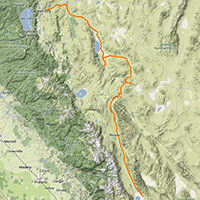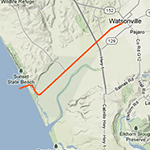

Narrow Gauge Railroads of California.
Common Carrier Railroads.

Arcata & Mad River Railroad.
45.25in Gauge. Incorporated July 16, 1881, the 12.9 mile long Arcata and Mad River Railroad provided access to the timber lands along the Mad River between Arcata and Korbel. Prior to the Aamp;MR railroad the Union Plank Walk & Rail Track Company, incorporated December 15, 1854, had provided service along the 2.5 mile long wharf in Arcata. The two companies operated narrow gauge service for a total of 88 years being both the oddest gauge and earliest railroad in California. The A&MR continued on for an additional 50 years as a standard gauge railroad.Arcata to Korbel, Humboldt County. 1854-1942

Bodie & Benton Railway.
36" Gauge. Mining activity entered a boom in the Bodie area in the 1880s, the Bodie and Benton Railway was constructed in 1887 to meet the demand for timber by logging the forests South East of Mono Lake. The B&B's main line stretched from Bodie navigating steep grades and two switchbacks down to Mono Mills and the company sawmill.Bodie to Mono Mills, Mono County. 1887 - 1918

California & Nevada Railroad.
36" Gauge. Projected to build 250 miles from Emeryville to the Nevada state line. During 21 years of operation it remained under the control of several contractors and never ceased being under construction. Between 1885 and 1900 only 22.4 miles was completed and trains operated irregularly. After seven years of litigation the C&N ceased to exist in November 1902.Emery(ville) to Bryant(Orinda), Alameda and Contra Costa Counties. 1881 - 1902

Carson & Colorado Railroad.
36" Gauge. Constructed by the Virginia and Truckee railroad to tap the southern mining booms. The line was projected to connect to the Colorado river, a feat it never accomplished, ending construction in Hawley, CA (later called Keeler). The line remained barely profitable until it was finally sold to the Southern Pacific in 1900, becoming the Nevada & California RR in 1905.Mound House, NV to Hawley (Keeler), CA . 1882 - 1905

Colusa and Lake Railroad.
36" Gauge. Constructed in 1885 as the Colusa Railroad to connect with the Central Pacific at Colusa Junction (now Cortena). The 9.7 mile line reincorporated a year later as the Colusa & Lake and expanded 12.3 miles to Sites and the neighboring sandstone quarries. By 1913 the quarry output had declined and competition from the Southern Pacific and Northern Electric railroads forced the road to abandon in May, 1915.Colusa to Sites, Colusa County. 1885 - 1918

Death Valley Railroad.
36" Gauge. Connected the Pacific Coast Borax Company mines around “New” Ryan with their concentrator at Death Valley Junction on the Tonopah and Tidewater Railroad. At Ryan, a 2’ gauge operation dubbed the “Baby Gauge” brought borax from the mines for transshipment. In 1927 the mines became unprofitable and a branch (dual gauge) laid north to service a clay pit in Ash Meadows.Death Valley Junction to "New" Ryan, Inyo County. 1914 - 1931

John Harford's Railroad.
30" Gauge. Horse drawn tramway constructed by John Harford beginning in 1871 to service the wharf at Point San Luis. Construction proceeded slowly from wharf inland to the People's Wharf Co. warehouse in San Luis Valley (Later Avila). Operation of freight and passengers over the line began in 1873. In mid-1874 John Harford sold the operation to the San Luis Obispo & Santa Maria Valley Railroad.Point San Luis to San Luis Valley (Avila), San Luis Obispo County. 1871 - 1874

Hetch Hetchy & Yosemite Valleys Railway.
36" Gauge. Incorporated by the West Side Flume & Lumber Co. to service the timber lands owned by the company and provide transportation to Yosemite National Park. The company sold to Michigan businessmen in 1903 and passenger service ended in August 1904. Operated as a private logging railroad as the West Side Lumber Co, the common carrier charter expired in 1943.Tuolumne to Thompson's Meadow, Tuolumne County. 1899 – 1904

Iron Mountain Railway.
36" gauge. Built by the Mountain Mines Syndicate LTD of England to move copper ore from the mine down to their smelter near Keswick. Later consolidated into the Mountain Copper Mining Company, it would become the largest copper producer in the state of California. By the 1920s the mine output began to decline and the line was abandoned in 1927.Keswick to Mines, Shasta County. 1895 - 1927

Lake Tahoe Railway & Transportation Company.
36" Gauge.Truckee to Tahoe City, Nevada and Placer Counties.

Monterey & Salinas Valley Railroad.
36" Gauge. California's first narrow gauge common carrier railroad. Constructed by local farmers upset by the Southern Pacific's tariff rates and seeking to establish their own railroad and port in Monterey bay. Within 4 years Nature and the Southern Pacific ultimately drive the line to bankruptcy. In 1879 the line is purchased and scrapped by the Southern Pacific with the equipment and rails sold to the newly formed Nevada Central Railway.Salinas to Monterey, Santa Cruz County. 1874 - 1879

Mount Diablo & San Jose Railroad.
36" Gauge. Operated from from Antioch to Livermore in the south utilizing the route of the Empire Coal Mine railroad. The line primarily hauled coal from the Mount Diablo mines and the occasional picnic train. A branch was planned to connect with the California and Nevada railroad, but the line was heavily damaged in the 1906 earthquake and construction ceased thereafter.Antioch to Livermore, Contra Costa County. 1900 – 1907

Nevada County Narrow Gauge Railroad.
36" Gauge. Constructed to connect the booming mining region around Grass Valley and Nevada City with the Central Pacific in Colfax, the line has the distinction of being the longest operating narrow gauge common carrier in California.Colfax to Nevada City, Nevada County. 1875 - 1942

North Pacific Coast Railroad.
36" Gauge. Constructed between 1874 and 1876 the NPC was constructed to reach valuable Redwood holdings of its financiers. Stretching from their ferry terminal in Sausalito to the vast logging country around Duncan's Mills the NPC was an important lifeline to the region and to San Francisco.Sausalito to Duncan Mills, Sonoma and Marin Counties. 1874 - 1908

Pacific Coast Railway.
36" Gauge.San Luis Obispo to Santa Maria & Los Alamos, San Luis Obispo & Santa Barbara Counties. 1882 - 1941

Pajaro Valley Consolidated Railroad.
36" Gauge. Owned and operated by the Claus Spreckels family, the main purpose of the Pajaro Valley Consolidated Railroad was to move sugar beets from farmers' fields to Spreckels beet sugar mills in Watsonville and Spreckels, California. The December 1897 incorporation of the PVCRR was a consolidation of the Pajaro Valley Railroad (incorporated January 1890) and the Pajaro Extension Railway (incorporated April 1897).Watsonville to Buena Vista, Santa Cruz and Monterey Counties. 1890 - 1929

Santa Cruz Railroad.
36" Gauge. Conceived by Frederick A. Hihn to bring railroad service to Santa Cruz. The line prospered only briefly, by 1880 the South Pacific Coast began competing service to Santa Cruz. By 1882 Hihn sold his interest in the company to the Southern Pacific Railroad and the line was standard gauged in 1883 becoming their Santa Cruz Branch. In 2012 the branch was sold to the Santa Cruz County Regional Transit Commission.Pajaro Junction to Santa Cruz, Salinas and Santa Cruz Counties. 1873 – 1883 (NG)

Santa Cruz & Felton Railroad.
36" Gauge. Built to move lumber to Santa Cruz, this 8 mile line began operation in October 1875. Alfred E. Davis purchased a controlling interest in the SC&F in 1879 and leased it to the South Pacific Coast Railroad. The SC&F retained its corporate identity until 1887 when it was merged with the SPC and other subsidiaries to become the South Pacific Coast Railway. Most of the railroad exists today as part of the standard gauge Santa Cruz, Big Trees and Pacific Railroad.Felton to Santa Cruz, Santa Cruz County. 1875 - 1887

San Joaquin & Sierra Nevada Railroad.
36" Gauge. Incorporated in 1882 to connect the growing population of Calaveras County and its farmers with the deep water ports of San Francisco. The line was completed in 1885 from Brack's Landing in the Sacramento River Delta with Valley Springs in the foothills, sold to the Southern Pacific in 1888 parts of the line surved late into the 20th century as the Southern Pacific's "Kentucky House Branch".Brack's Landing to Valley Springs, San Joaquin County. 1882 - 1904

San Luis Obispo & Santa Maria Valley Railroad.
36" Gauge.San Luis Obispo to Santa Maria & Los Alamos, San Luis Obispo & Santa Barbara Counties. 1875 - 1882

Stockton & Ione Railroad.
36" Gauge. Proposed to build from Stockton to the liginite fields near Ione. The project was beset with trouble from the start and managed to grade 12 miles to Linden, constructing 5 miles of track to the eastern edge of Stockton. An economic downturn forced the line into bankruptcy and the company's assets were sold at Sheriff's auction in July, 1876.Stockton to Ione (Proposed), San Joaquin & Amador Counties. 1874 - 1876

Sonoma Valley Railroad.
36" Gauge. Constructed from the route of the Sonoma Valley Prismoidal, the Sonoma Valley Railroad was the answer to Sonoma's desire for a railroad. With extensions to Glen Ellen and later Ignacio, for several years the line was a subsidary of Peter Donahue's San Francisco and North Pacific Railroad. In 1889, the Sonoma Valley Railroad merged with the SF&NP and was standard gauged in 1890.San Pablo Bay to Glen Ellen, Sonoma County. 1878 - 1890

South Pacific Coast Railroad.
36" Gauge. Incorporated March 5, 1876 from an original concept of providing transportation to sell real estate in Newark, California, it became one of the most successful narrow gauge railroads in California. In 1887 it was sold to the Southern Pacific which operated the narrow gauge railroad until 1909.San Francisco, Alameda, Santa Clara, and Santa Cruz Counties. 1876-1909

State Harbor Belt Railroad.
Dual Gauge. While not fully a narrow gauge, the State Harbor Commission constructed and operated an expansive dual gauge system along the harbor in San Francisco. The railroad served the Atcheson Topeka & Santa Fe, Central/Southern Pacifc, North Pacific Coast and South Pacific Coast Railroads switching incoming freight cars from the ferries to industries and yards along the waterfront.San Francisco, San Francisco County. 1890 - 1915.

Watsonville Transportation Company.
36" Gauge. Constructed by local interests to bypass Claus Spreckles and the Southern Pacific freight monopolies in their region. Initially profitable, the line struggled in the face of competition until the wharf at Port Rogers was destroyed by unforseen circumstances and needed replacement, forcing the line to suspend operations.Watsonville to Port Rogers, Salinas County. 1903 - 1906

Watsonville Railway & Navigation Company.
36" Gauge. After laying dormant and tied up in court proceedings for several years, the Watsonville Transportation Co. was revived in 1911 and operated until 1913 when the wharf at Port Watsonville was destroyed by a storm.Watsonville to Port Watsonville, Salinas County. 1911 - 1914

Yosemite Shortline Railway.
30" Gauge. Incorporated in 1905 the Yosemite Short Line was proposed to connect Jamestown on the standard gauge Sierra Railway with Yosemite National Park and the Hetch Hetchy Valley. Construction was disrupted by the April 18, 1906 earthquake in San Francisco. Portions of the route would later be used in construction of the standard gauge Hetch Hetchy Railroad.Jamestown to Yosemite (Proposed), Tuolumne County. 1905 - 1906
Logging Railroads.

A. M. Leach Lumber Company.
36" Gauge. Constructed by Andrew Martin Leach to bring timber from the woods to his mill in Challenge. Finished lumber from the mill was then sent by flume down to Honcutt on the Southern Pacific. The railroad was later extended to a new mill at Beantown. In 1892 Leach moved his railroad to the end of the flume at Owl Gulch.Challenge Mills to Beanville, Yuba County. 1884 - 1894

Brookings Box & Lumber Company.
36" Gauge. The Brooking Box & Lumber Co. owned 6000 acres of timberlands in the San Bernadino Mountains near Fredalba. Between 1901 and 1911 the company was generating 10,000,000 board feet of lumber per year. The company ceased operations on in June 1914.Fredalba, San Bernadino County. 1900 - 1914

Diamond and Caldor Railway.
36" Gauge. Constructed as a subsidiary of the California Door Company in 1904 to connect their mill in Caldor with the standard gauge Southern Pacific at Diamond Springs. In 1923 a fire destroyed the mill at Caldor which was replaced with a new sawmill in Diamond Springs. When the line failed to comply with ICC common carrier regulations, operations ceased on April 10, 1953.Diamond Springs to Caldor, El Dorado County. 1900 - 1953

Donner & Tahoe Railroad.
36" Gauge. Built by the Pacific Wood & Lumber Company on contract to operate a railroad over land owned by the Truckee Lumber Company. The railroad hauled logs from Truckee Lumber Co. and Pacific Wood & Lumber Co. timberlands down to the Truckee Lumber Co. mill on the western side of Truckee. The Pacific Wood & Lumber Co. was purchased by the Truckee Lumber Co. in 1901 and the railroad was dismantled.Truckee Area, Nevada County. 1893 - 1901

D. H. McEwen Lumber Company.
36" Gauge. Operated a six-mile long railroad from the mill near Cazadero, up the South Fork of the Gualala River on what is now the Bohan-Dillon Road. Lumber from the mill was hauled by wagon team down to Fort Ross - Cazadero Road, where it was transferred to the Northwestern Pacific Railroad.South Fork of the Gualala River, Medocino County. 1906 - 1917

Empire City Railway.
30" Gauge. Constructed by Sierra Railway interests using the equipment and workforce from the failed Yosemite Short Line project. The operation was purchased by the Standard Lumber Company in 1907. Operations ended in 1913 after the mill and lumber were destroyed by fire.Empire City, Stanislaus County. 1906 - 1913

Greenhorn Railroad.
36" Gauge. Built by Charles W. Kitts to connect his mill on the Greenhorn river with the Nevada County Narrow Gauge. Cars of the NCNG would travel to mill by way of horse teams and later a small locomotive, there they were loaded and returned to Greenhorn Junction for shipment to Grass Valley, Nevada City or Colfax.Greenhorn Creek Area, Nevada County. 1891 - 1912

Hume-Bennett Lumber Company.
36" Gauge. Thomas Hume and Ira Bennett gained control of the Sanger Lumber Company in 1905. Operations were expanded and a large mill was constructed at Hume. After the Hume-Bennett partnership dissolved in 1912, Operations retained the name until it was renamed back to the Sanger Lumber Company between 1917 and 1927.Tulare County. 1905 - 1917

Johnson - Pollock Lumber Company.
36" Gauge. Incorporated in 1912 to harvest timber from the northern slope of Mt. Hebron. The company operated several miles of track from Jerome up the mountain and utilized a Shay locomotive. In 1919 the mill at Jerome burned down and the railroad equipment sold to the nearby Mt. Hebron Lumber Company.Jerome, Siskiyou County. 1912 - 1920

Kings River Lumber Company.
36" Gauge. Constructed by the Moore & Smith Lumber, San Francisco, oprtsyion began in the vicinity of Sequoia Lake and Converse Basin. The operation utilized two sawmills, a rough cut mill above the snow line and a larger mill with drying yard below the snow line. Both operated independent rail systems. The upper mill utilized a horse tramway, while the lower mill operated a 2 mile railroad called the “Sequoia Railroad”.Tulare County. 1888 - 1894

Marsh Lumber Company.
36" Gauge. The Marsh Lumber company acquired the Horton Brothers Lumber Co. assets in 1907. During 1910 seven miles of narrow gauge were built out of Horton Landing on the Boca & Loyalton. Financial trouble in October 1917 saw the operation sold to the Clover Valley Lumber Co. and the grade subsequently standard gauged in 1920.Sierra County. 1906 - 1917

Michigan-California Lumber Company.
36" Gauge. Formed from the merger of the R. E. Danaher Lumber Co. and Michigan lumberman John Blodgett's timber holdings on the Georgetown ridge. The company operated a unique cable tramway over the American river gorge and an expansive mills in Pino Grande and Camino. A fire destroyed the southern tower of the tramway and the operation switched to trucks in 1949.El Dorado County. 1885 - 1940

Molino Timber Company.
30" Gauge. The Molino Timber Company was incorporated in 1911 as a subcontracting company of the Loma Prieta Lumber Company. Operating an incline with an elevation of 657 ft and a maximum grade of 67 percent the line operated a few years before its equipment was sold to the Loma Prieta Lumber Company.Molino Station to Camp #3, Santa Cruz County. 1911 - 1920

Sanger Lumber Company.
36" Gauge. In 1895 the creditors of the failed Kings River Lumber Co., reorganized the company as the Sanger Lumber Company. Operations were moved 5 miles east of the former mill site at Millwood, to the Converse Basin. The company operated in the red over the next 10 years and was ultimately sold in 1905 to Thomas Hume and Ira Bennett, becoming the Hume-Bennett Lumber Company.Converse Basin. Tulare County. 1895 - 1905

Sierra Lumber Company.
Meter Gauge. Formed through the consolidation of 3 different logging interests, the Sierra Lumber Company constructed and operated several horsedrawn tramways. In 1880 a tramway near Lyonsville was converted to a strap iron railroad and by 1900 the operation was profitable enough to build a second line along Chico Creek. In 1907 the company became part of the Diamond Match Company.Operations Near Lyonsville and Chico Creek. Butte, Tehama and Plumas Counties. 1881 - 1907

Sierra Nevada Wood & Lumber Company.
36" and Standard Gauge. After exhausting their timber holdings at Incline on Lake Tahoe, the Sierra Nevada Wood & Lumber Co. constructed a new railroad along Upper Prosser Creek at Overton, later called Hobart Mills. The company operated narrow gauge logging lines through 5000 square miles of forest. The company was dissolved, becoming part of the Hobart Estate Company in 1917.Hobart Mills to Sierraville Summit, Nevada and Sierra Counties. 1896 - 1917

Sloat Lumber Company.
30" Gauge. Constructed from Sloat to the Poplar Valley and Peoria Creek area utilizing second hand equipment from the Empire City Railway. In 1918 the Sloat Lumber Co. and Quincy Lumber Co. were purchased by the F. S. Murphy Lumber Company of Utah. From 1926 to 1936 it was operated as part of the Quincy Lumber Co.Sloat, Plumas County. 1917 - 1936

Spanish Peak Lumber Company.
36" Gauge. Incorporated by O.C. Hassett and Duane L Bliss Jr. in 1917, the company initially used trucks to haul logs to Quincy for shipment to the company mill at Gray's Flat (later called Twain) on the Feather River. A 36" gauge railroad was constructed in 1925 to move logs down to a mill near Spanish Ranch. From there a 5 mile long aerial cable tramway carried logs north to the mill at Gray's Flat.Spanish Ranch (Mill) to Camp 4, Plumas County. 1925 - 1935

Towle Brothers Lumber Company.
36" Gauge. Constructed during the 1880s the Towle Brothers operated a vast narrow gauge system out of Towle station along the Central Pacific. By the late 1890s the lumber supply began to dwindle and the Towle Bros relocated their operation to Fulda. In 1902 shortly after George Towle's death the family sold the operation to the Reed Lumber Co. of Canada.Towle to a point near Omega, Nevada County. 1885 - 1902

West Side Lumber Company.
36" Gauge. Reorganized by Michigan businessmen from the Hetch Hetchy & Yosemite Valleys Railroad. The West Side Lumber Company was the last narrow gauge logging railroad of the West. At it's peak the company operated 250 miles of track including 72 miles of mainline. Trucks replaced the railroad in 1961 and operations ceased in 1962.Tuolumne to Camp 44 (Near Cherry Creek), Tuolumne County. 1903 - 1962
Mining Railroads.

American Borax Company: Columbia Mine Railroad.
36" gauge. Known as the "ABC" Railroad locally, the American Borax Co. operated a short railroad connecting their Columbia mine with a processing plant in Daggett. A portion of the line utilized shared/leased trackage from the Waterloo Mining Company and was later purchased when that company ceased operation. The mine was closed and the equipment sold in 1907.Daggett, San Bernardino County. 1900 - 1907

Calico Railroad.
36" gauge. Hauled silver ore from mines near Calico down to the mill at Daggett. Known variously as the: Daggett & Calico Railroad, the Waterloo Mining Company Railroad, Oro Grande Mining Railroad, occasionally the Calico & Daggett, or simply the Calico Railroad. Some names were official, some reflected the ownership at one point, and others simply described where the railroad located or the points connected.Daggett, San Bernardino County. 1888 - c.1903

Dairy Farm Mining Company.
36" gauge. Constructed to carry copper ore from the Dairy Farm Mine to a transfer trestle along the Southern Pacific Railroad's mainline near Sheridan. The operation was short lived, operating a single season before shutting down.Sheridan to Van Trent, Placer County. 1913 – 1914

Los Angeles Municipal Cement Mill.
36" gauge. Constructed by the city of Los Angeles to supply cement to the Los Angeles Aqueduct project in 1907. To move material from the quarry a narrow gauge railroad was constructed. The mill continually produced cement through the completion of the aqueduct in 1913 and ceased operation in 1915.Aqueduct (Later called Monolith), Kern County. 1906 - 1921

Merced Gold Mining Company.
24" gauge. Formed in 1894 through the conglomeration of 26 quartz mines. Initially a 24" gravity tramway, the line purchased an 8 ton Porter locomotive in 1897 affectionately called the "Whistling Billy". The line helped extract nearly $800,000 worth of gold until operations ceased in 1904.Near Coulterville, Mariposa County. 1896 - 1904

Monolith Portland Cement
36" gauge. In 1922 the Monolith Portland Cement Company was incorporated to operate the former Los Angeles Municipal Cement Mill at Monolith. The railroad serving the quarry continued operation for 50 years until it ceased operation in 1973. Today the plant continues to operate as the Lehigh Southwest Cement Company.Monolith, Kern County. 1922 - 1973

Old Mission Portland Cement Company.
36" gauge. Old Mission Portland Cement Company of San Juan Bautista, owned a gauge quarry railroad, and was associated with and was the majority owner of the standard gauge California Central Railroad (previously the San Juan Pacific Railway). This railroad connected the town of San Juan Bautista and the cement plant with the Southern Pacific Railroad at Chittenden on the Pajaro River.San Juan Bautista, San Benito County.

Pacific Coast Borax Company: "Baby Gage" Railroad
24" gauge. Constructed to bring ore from the “Grand View”, “Lizzie J. Oakley” and “Widow” mines to an ore tipple in Ryan for transloading to Death Valley Railroad cars. The line was initially 3 miles long and later extended to over 5 miles.Ryan Area, Inyo County. 1914 - 1950

Pacific Coast Borax Company: Gerstley Mine Railroad
24" gauge. 3 miles long, connecting the Gerstley Mine with a connection with the Tonopah & Tidewater Railroad, at Gerstley Siding, 4 miles north of Shoshone.Gerstley Siding, Inyo County. 1922 - 1927

Pacific Coast Borax Company: Lila C. Tramway.
Dual Gauge. 6.7 miles long, connected the Lila C. Mine with the Tonopah & Tidewater Railroad at Death Valley Junction. Originally constructed as a standard gauge branch it was later converted to dual gauge by the Death Valley Railroad. The branch was removed in 1917 but relaid as narrow gauge only in 1920 and operated until 1926.Death Valley Junction to Ryan, Inyo County. 1907 - 1926

Quartz Hill Railroad.
36" gauge. Constructed by the Mammoth Copper Mining Company in 1904 to supply quartz for use in mining flux for the company smelter at Keswick. The 3.5 mile railroad connected the leased quartz hill gold mine in the “old diggings” mining district with Cuargo on the Southern Pacific Railroad. The quartz supply played out in 1915 and the railroad was torn up.Cuargo to Quartz Hill Mine, Shasta County. 1904 - 1915

Palm Borate.
30" gauge. Constructed to haul borax from the company mine to the to the plant. After completion, the line operated 10 days before the price of borax dropped out and the operation closed.Daggett, San Bernardino County. 1908 - 1908

United States Gypsum
36" Gauge. Started life as the Imperial Valley Gypsum and Oil Corporation, later owned by the Pacific Portland Cement Company. The United States Gypsum Company continues to operate the 20.5 mile line, hauling gypsum from the mine to the processing plant in Plaster City where it is transloaded to standard gauge cars on the San Diego and Imperial Valley Railroad.Plaster City, Imperial County. 1921 – Present
Industrial Railroads.

El Dorado Lime & Mineral Company.
36" gauge. Operated a large underground limestone mine near Shingle Springs at a place called “Sprecklesville”. Initially constructed a 1.9 mile long narrow gauge system to connect the mine with the Central Pacific's Placerville branch at Limestone (MP 133.5). This lasted until 1918 when kilns were relocated to Bullard (MP 131.7) in late 1918. The operation converted to standard gauge around 1925 operated until the late 1970s.Limestone to Sprecklesville, El Dorado County. 1916 - 1925(NG)

Italian Vineyard Company.
30" gauge. The Italian Vineyard Company was once the largest single vineyard in the world. To move grapes around the expansive property a railroad was constructed. Track of temporary and permanent nature was constructed upward of 22 miles total. Trucks began to replace the railroad in the 1920s and the railroad was removed by 1940.Guasti (Cucamonga), San Bernadino County. 1908 - ca. 1940

Natomas Consolidated Company.
36" gauge. Formed through the consolidation of several dredging companies that engaged in mining and reclamation on the Sacramento and American Rivers. The company operated rock crushing facilities at Natoma, Fair Oaks and Oroville. Processed rock was graded and sold as architectural cobble and crushed gravel for highway paving projects throughout the central valley.Natomas and Fair Oaks, Sacramento County. Oroville, Butte County. 1909 – 1962.

State Harbor Belt Railroad.
Dual Gauge. While not fully a narrow gauge, the State Harbor Commission constructed and operated an expansive dual gauge system along the harbor in San Francisco. The railroad served the Atcheson Topeka & Santa Fe, Central/Southern Pacifc, North Pacific Coast and South Pacific Coast Railroads switching incoming freight cars from the ferries to industries and yards along the waterfront.San Francisco, San Francisco County. 1890 - 1915.
Transit.

Watsonville Transportation Company.
36" Gauge. Constructed by local interests to bypass Claus Spreckles and the Southern Pacific freight monopolies in their region. Initially profitable, the line struggled in the face of competition until the wharf at Port Rogers was destroyed by unforseen circumstances and needed replacement, forcing the line to suspend operations.Watsonville to Port Rogers, Salinas County. 1903 - 1906

Watsonville Railway & Navigation Company.
36" Gauge. After laying dormant and tied up in court proceedings for several years, the Watsonville Transportation Co. was revived in 1911 and operated until 1913 when the wharf at Port Watsonville was destroyed by a storm.Watsonville to Port Watsonville, Salinas County. 1911 - 1914
Oddities.

Aerial Trolley Car Company.
Monorail. Lightweight monorail system developed by Joseph W. Fawkes. To demonstrate the system as a viable transportation conveyance he constructed a track 800 feet long and propeller powered, 56 passenger trolley car named the "Aerial Swallow". Fawkes attempted to franchise his invention to local cities, proposing a system into download Los Angeles. After a trial run it was nicknamed "Fawkes' Folly" and the system was scrapped some time after 1929.Burbank, Los Angeles County. 1910 - 1929

Farallon Midland.
36" Gauge Tramway. Constructed by the U.S. Navy to haul supplies around Southeast Farallon Island. Originally powered by burros, the line nearly encircled the island servicing a steam plant on the island. Today the island is a national wildlife preserve, but the line continues to serve the needs of researchers on the island.Farallon Islands, San Francisco County. 1880 - Present

Las Casitas Railway.
Hillevator. Operated a one mile loop around the central area of the L. A. County Fairplex. The original system was upgraded in the late 1980s. The new system was troubled from the start and the entire system was subsequently removed in 1996.San Francisco, San Francisco County. 1960 - Present

Los Angeles County Fairplex Monorail.
Monorail. Operated a one mile loop around the central area of the L. A. County Fairplex. The original system was upgraded in the late 1980s. The new system was troubled from the start and the entire system was subsequently removed in 1996.Los Angeles County Fairplex, Los Angeles County. 1962 - 1996

Mission Bay Prismoidal.
Prismoidal Railway. Constructed to demonstrate Prismoidal Railway operation on the San Francisco peninsula. Line was used as part of the project to fill in Mission Bay.Mission Bay Area, San Francisco. 1875

Sonoma Valley Prismoidal.
Prismoidal Railway. Considered to be the first monorail system in California. The Sonoma Valley Prismoidal was constructed following the Crew Patent One-Rail Railway system. The line operated a short 6 months before being declared a failure. Portions were later converted to 3' gauge as part of the Sonoma Valley Railroad.Norwalk to Schelleville, Sonoma County. 1876
Tourist.




